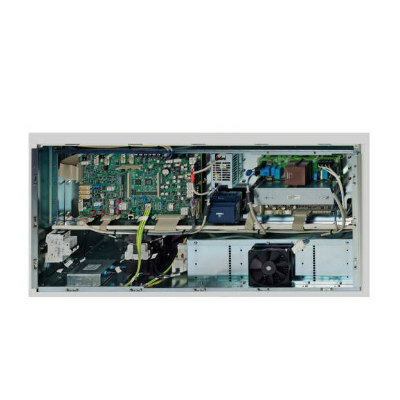Carestream Exhibits Expanded Clinical Collaboration Platform at ECR
|
By MedImaging International staff writers Posted on 16 Mar 2016 |
At each annual meeting of the European Congress of Radiology (ECR), Carestream (Rochester, NY, USA) never fails to exhibit a new technology or platform in the world of data sharing. This year was no different. The leader in health IT and radiology technology demonstrated its Clinical Collaboration Platform enabling the sharing of images in real time, aiding interactive working, and improving the efficiency of service delivery.
By providing a complete enterprise imaging platform with patient-centered views of clinical imaging data across departments and sites, the Carestream Clinical Collaboration Platform provides every stakeholder with a modular solution for meaningful collaboration across the continuum of care. This is delivered via the solid enterprise viewer part of the platform itself.
Stefano Arata, Carestream Solution Architect for the EMEA region told Medical Imaging International why the development of the Clinical Collaboration Platform was pushing the boundaries of clinical information sharing into new territory.
As a concept, the Clinical Collaboration Platform embodies joint working between physicians, across departments and multiple sites within a healthcare region. It provides an overarching, standards-based platform to manage all imaging data, radiology, videos, photos, electrocardiograms (ECGs) and scanned documents. This is a perfect “enabler” for the electronic medical records (EMR) that is not focused on image sharing.
Carestream has been a leader in radiology imaging for many years, but more recently the field of image exchange in radiology has adopted a position of increasing importance in their portfolio. “We now realize the significance of offering an enterprise imaging platform to enable physicians to collaborate across the clinical pathway across hospitals and medical professionals,” said Arata. “We want to provide access to images that might be captured in different locations enabling all relevant physicians and patients to access these data.”
Of note, the Platform is comprised of a set of modules and an enterprise repository consisting of a standard vendor neutral archive (VNA) incorporated with the ability to integrate with EMR. This is a function that is normally missing from the VNA. “We also provide the workflow because we know how important it is to acquire the images and capture them in such a way that they are properly managed,” he added. The Clinical Collaboration Platform provides all the tools needed to ensure this happens and that images are securely shared with those people who need them.
Furthermore, in the near future, patients will be able to upload their own data, added Arata. He cited the example of patients being able to upload their images and make them available to the hospital before attending appointments. “There’s a high demand for this,” he said.
Also, at ECR, Carestream announced a new development whereby images become available to different stakeholders in real time, providing the possibility for clinicians to share the same images at the same time, for example when holding a remote joint case discussion meeting. “This is very useful for doctors who often wish to discuss cases using images and be able to point to areas of the image in real time with their colleagues,” further explained Arata. “This capability is now embedded in the viewers so that a user can send an invitation to other professionals to view simultaneously.”
Related Links:
Carestream
By providing a complete enterprise imaging platform with patient-centered views of clinical imaging data across departments and sites, the Carestream Clinical Collaboration Platform provides every stakeholder with a modular solution for meaningful collaboration across the continuum of care. This is delivered via the solid enterprise viewer part of the platform itself.
Stefano Arata, Carestream Solution Architect for the EMEA region told Medical Imaging International why the development of the Clinical Collaboration Platform was pushing the boundaries of clinical information sharing into new territory.
As a concept, the Clinical Collaboration Platform embodies joint working between physicians, across departments and multiple sites within a healthcare region. It provides an overarching, standards-based platform to manage all imaging data, radiology, videos, photos, electrocardiograms (ECGs) and scanned documents. This is a perfect “enabler” for the electronic medical records (EMR) that is not focused on image sharing.
Carestream has been a leader in radiology imaging for many years, but more recently the field of image exchange in radiology has adopted a position of increasing importance in their portfolio. “We now realize the significance of offering an enterprise imaging platform to enable physicians to collaborate across the clinical pathway across hospitals and medical professionals,” said Arata. “We want to provide access to images that might be captured in different locations enabling all relevant physicians and patients to access these data.”
Of note, the Platform is comprised of a set of modules and an enterprise repository consisting of a standard vendor neutral archive (VNA) incorporated with the ability to integrate with EMR. This is a function that is normally missing from the VNA. “We also provide the workflow because we know how important it is to acquire the images and capture them in such a way that they are properly managed,” he added. The Clinical Collaboration Platform provides all the tools needed to ensure this happens and that images are securely shared with those people who need them.
Furthermore, in the near future, patients will be able to upload their own data, added Arata. He cited the example of patients being able to upload their images and make them available to the hospital before attending appointments. “There’s a high demand for this,” he said.
Also, at ECR, Carestream announced a new development whereby images become available to different stakeholders in real time, providing the possibility for clinicians to share the same images at the same time, for example when holding a remote joint case discussion meeting. “This is very useful for doctors who often wish to discuss cases using images and be able to point to areas of the image in real time with their colleagues,” further explained Arata. “This capability is now embedded in the viewers so that a user can send an invitation to other professionals to view simultaneously.”
Related Links:
Carestream
Latest Imaging IT News
- New Google Cloud Medical Imaging Suite Makes Imaging Healthcare Data More Accessible
- Global AI in Medical Diagnostics Market to Be Driven by Demand for Image Recognition in Radiology
- AI-Based Mammography Triage Software Helps Dramatically Improve Interpretation Process
- Artificial Intelligence (AI) Program Accurately Predicts Lung Cancer Risk from CT Images
- Image Management Platform Streamlines Treatment Plans
- AI-Based Technology for Ultrasound Image Analysis Receives FDA Approval
- AI Technology for Detecting Breast Cancer Receives CE Mark Approval
- Digital Pathology Software Improves Workflow Efficiency
- Patient-Centric Portal Facilitates Direct Imaging Access
- New Workstation Supports Customer-Driven Imaging Workflow
Channels
Radiography
view channel
Novel Breast Imaging System Proves As Effective As Mammography
Breast cancer remains the most frequently diagnosed cancer among women. It is projected that one in eight women will be diagnosed with breast cancer during her lifetime, and one in 42 women who turn 50... Read more
AI Assistance Improves Breast-Cancer Screening by Reducing False Positives
Radiologists typically detect one case of cancer for every 200 mammograms reviewed. However, these evaluations often result in false positives, leading to unnecessary patient recalls for additional testing,... Read moreMRI
view channel
PET/MRI Improves Diagnostic Accuracy for Prostate Cancer Patients
The Prostate Imaging Reporting and Data System (PI-RADS) is a five-point scale to assess potential prostate cancer in MR images. PI-RADS category 3 which offers an unclear suggestion of clinically significant... Read more
Next Generation MR-Guided Focused Ultrasound Ushers In Future of Incisionless Neurosurgery
Essential tremor, often called familial, idiopathic, or benign tremor, leads to uncontrollable shaking that significantly affects a person’s life. When traditional medications do not alleviate symptoms,... Read more
Two-Part MRI Scan Detects Prostate Cancer More Quickly without Compromising Diagnostic Quality
Prostate cancer ranks as the most prevalent cancer among men. Over the last decade, the introduction of MRI scans has significantly transformed the diagnosis process, marking the most substantial advancement... Read moreUltrasound
view channel
Deep Learning Advances Super-Resolution Ultrasound Imaging
Ultrasound localization microscopy (ULM) is an advanced imaging technique that offers high-resolution visualization of microvascular structures. It employs microbubbles, FDA-approved contrast agents, injected... Read more
Novel Ultrasound-Launched Targeted Nanoparticle Eliminates Biofilm and Bacterial Infection
Biofilms, formed by bacteria aggregating into dense communities for protection against harsh environmental conditions, are a significant contributor to various infectious diseases. Biofilms frequently... Read moreNuclear Medicine
view channel
New SPECT/CT Technique Could Change Imaging Practices and Increase Patient Access
The development of lead-212 (212Pb)-PSMA–based targeted alpha therapy (TAT) is garnering significant interest in treating patients with metastatic castration-resistant prostate cancer. The imaging of 212Pb,... Read moreNew Radiotheranostic System Detects and Treats Ovarian Cancer Noninvasively
Ovarian cancer is the most lethal gynecological cancer, with less than a 30% five-year survival rate for those diagnosed in late stages. Despite surgery and platinum-based chemotherapy being the standard... Read more
AI System Automatically and Reliably Detects Cardiac Amyloidosis Using Scintigraphy Imaging
Cardiac amyloidosis, a condition characterized by the buildup of abnormal protein deposits (amyloids) in the heart muscle, severely affects heart function and can lead to heart failure or death without... Read moreGeneral/Advanced Imaging
view channel
New AI Method Captures Uncertainty in Medical Images
In the field of biomedicine, segmentation is the process of annotating pixels from an important structure in medical images, such as organs or cells. Artificial Intelligence (AI) models are utilized to... Read more.jpg)
CT Coronary Angiography Reduces Need for Invasive Tests to Diagnose Coronary Artery Disease
Coronary artery disease (CAD), one of the leading causes of death worldwide, involves the narrowing of coronary arteries due to atherosclerosis, resulting in insufficient blood flow to the heart muscle.... Read more
Novel Blood Test Could Reduce Need for PET Imaging of Patients with Alzheimer’s
Alzheimer's disease (AD), a condition marked by cognitive decline and the presence of beta-amyloid (Aβ) plaques and neurofibrillary tangles in the brain, poses diagnostic challenges. Amyloid positron emission... Read more.jpg)
CT-Based Deep Learning Algorithm Accurately Differentiates Benign From Malignant Vertebral Fractures
The rise in the aging population is expected to result in a corresponding increase in the prevalence of vertebral fractures which can cause back pain or neurologic compromise, leading to impaired function... Read moreIndustry News
view channel
Bayer and Google Partner on New AI Product for Radiologists
Medical imaging data comprises around 90% of all healthcare data, and it is a highly complex and rich clinical data modality and serves as a vital tool for diagnosing patients. Each year, billions of medical... Read more



















